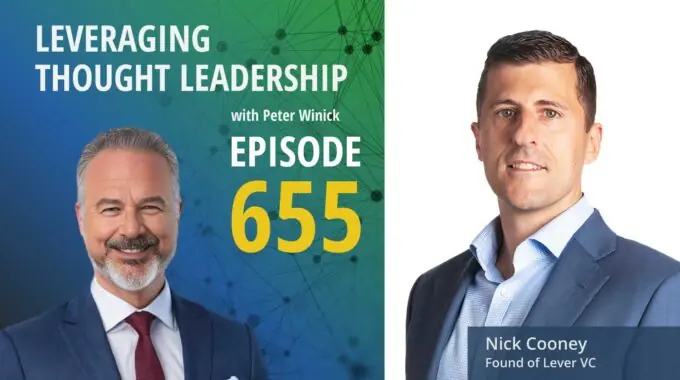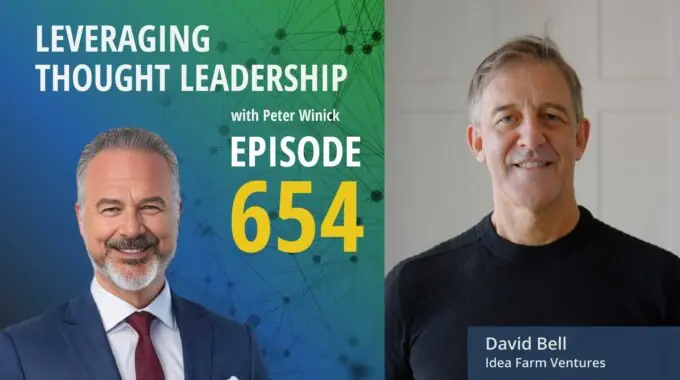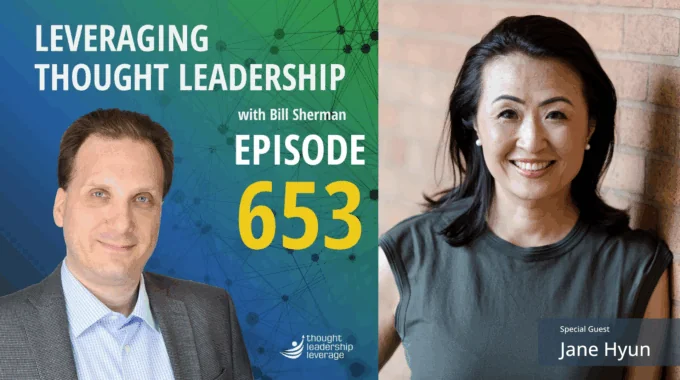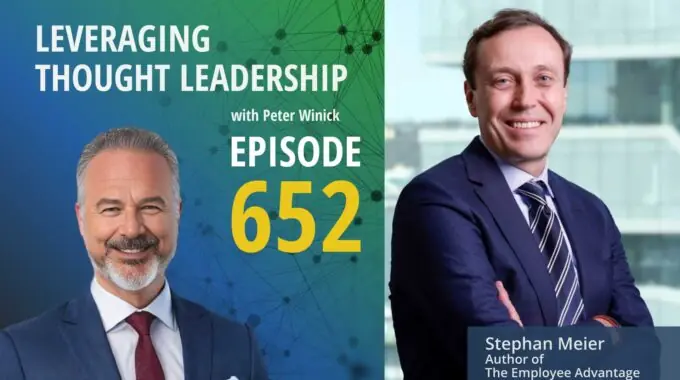How Strategic Content Fuels Growth in Purpose-Led Ventures This episode explores how thought leadership can…
The Value and Energy of Thought Leadership | Liz Brunner
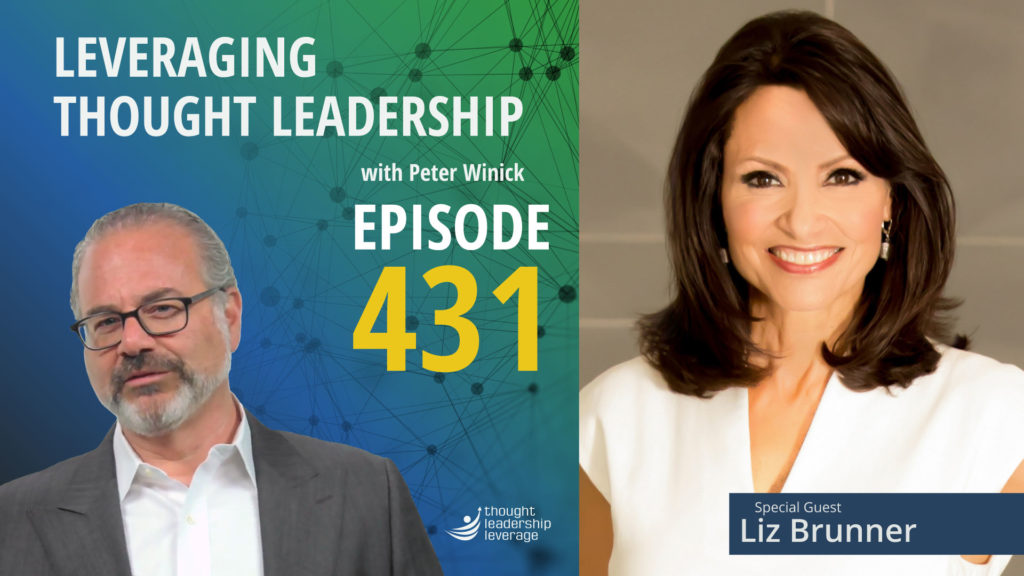
How to bring value and energy virtually in order to move the dial.
An interview with Liz Brunner about connecting with clients and audiences in person and virtually.
How do you connect a high-profile brand with its best audience?
Through great storytelling!
Liz Brunner is the Founder and CEO of Brunner Communications, assisting high-profile individuals and organizations in developing powerful, meaningful, and desirable brand identities. She is also the Founder of Brunner Academy of Online Learning, and the author of Dare to Own You: Taking Your Authenticity and Dreams into Your Next Chapter.
Liz has had a number of professions over the course of her career, from high school music teacher to Emmy Award-winning news anchor. She explains that the key to her success can be summed up in two words: great storytelling. When you know the secrets of storytelling, you can capture the attention of your audience and keep them hooked.
Having worked both in person and on television, it was easy for Liz to transition her work into the digital space after the pandemic started – in fact, she began to teach others how to engage in the virtual space and still move the dial. She shares why digital presenters need to think like TV stars, and how to get your audience to feel your presence – even through the lens.
Our final topic revolves around the energy gained from working face-to-face, versus the newfound advantages of the digital space. Liz explains the pros and cons of each, and how to connect, communicate, and engage, developing the keys to success regardless of your medium.
Three Key Takeaways:
- When presenting virtually and using slides keep things moving! Use more slides with less content on each or include animations to keep the audience constantly engaged.
- Looking directly into the camera when working online gives a feeling that you are looking directly at every member of your audience and engages them more.
- While putting a message together you need to hook people right away, if you don’t you’ll miss an opportunity for your brand (personally and for your company).
If you need a strategy to bring your thought leadership to market, Thought Leadership Leverage can assist you! Contact us for more information. In addition, we can help you implement marketing, research, and sales. Let us help you so you can devote yourself to what you do best.
Transcript
Peter Winick And welcome, welcome, welcome. This is Peter Winick. I’m the founder and CEO at Thought Leadership Leverage. And you’re joining us on the podcast today, which is Leveraging Thought Leadership. Today, my guest is Liz Brunner. She’s the CEO and founder of Rudder Communications and the bestselling author of Dear to Own You Taking Your Authenticity and Dreams Into Your Next Chapter. In 2020, she launched her podcast, Live Your Best Life with Liz, and in 2020, she founded the Brunner Academy of Online Learning. And then if we keep going backwards, we get into her broadcast and television career and all sorts of cool things being on the board of directors of Make-A-Wish, Massachusetts. Let’s just let’s just dove in. So welcome aboard today, Liz. How are you?
Liz Brunner Thank you so much, Peter. Great to be with you today. I appreciate you having me on the show.
Peter Winick Great. So how did how do you go from you’ve got a classically trained vocal performer to media, to online learning, to author, to talking to us today. So how did that plan come to be?
Liz Brunner Well, just think of one word – storytelling. If you think about it. A lot of people have said to me, how did you go from being a, you know, a high school music teacher singing across the world to being in television, etc.? It’s all storytelling. Storytelling when you’re performing. I’m sharing stories. When I was on the news, you’re sharing stories, and now I’m helping other people tell their stories, as well as share my own story a little bit more in my book, Dare to Own You. So, there’s a theme here of storytelling from the beginning to the end.
Peter Winick Okay, so let’s talk about how that’s a universal need, right? And then life happens and changes things, right? So, we used to tell stories in a certain way, in a certain format, go to a meeting meant physically leave the house or hands on it for fun stuff. What’s the same and what’s different today?
Liz Brunner Oh. Thank you for asking that question because a lot of people have been taught, let me tell you what I’m going to tell you. Then they tell me and then they remind me what they’ve just told me. I firmly believe that is so old school today. It just does not work. You have to capture people’s attention from the moment you begin. From the moment you begin, you’ve got to get their attention in the first 8 to 10 seconds or you’ve lost them.
Peter Winick So stay there for a second because I agree with you 10,000%. And the problem that I encounter with a lot of our clients, authors, thought leaders, speakers, whatever is they’re really, really smart. They’re really, really good at what they do. And they weren’t trained in this world of, you know, you literally have to shake people out of their trance to get their attention. And you don’t want to go kitschy and, you know, put your hair on fire and sort of silliness. But certain things take a little unpacking and take a little bit of explaining and let me understand, let me have you understand my model and I’ve researched this and whatever. How do you get both of those two to be true at the same time?
Liz Brunner You need to reverse the process. And what I mean by that is, yes, there is an open, which I call the hook, there is the middle, which is the myth, the nuts and bolts, there is the close. But what I tell people to do when I work with my clients on how to put their remarks together, how to put their message, their story, quote unquote. And I’m not saying you’re making stuff up. These are facts. Yeah, I call it a story. You start with the end first. And I like people to think about, okay, what’s the takeaway? What does my audience care about now? What I think they care about, but what does my audience care about? Which means it’s about them, not about you. And you have to find that nugget, those nuggets. That’s the first place to start. And once you start there a ha now you can begin to create the hook and pull people in. What a lot of people do besides that, let me tell you what I’m going to tell you theory that I throw it out there. They feel they have to have this huge setup. Well, this is our mission and this is how we got here. And we’ve been doing this for 15, 20 years and our company assets are blah, blah, blah, blah, blah. I’m not saying that’s not important, but that’s not how you begin.
Peter Winick Right? In the current universe, our default setting is virtual, right? So it used to be, if I’m of a certain age and been doing things a certain way for a certain time, whether I’m a sales person or a leader or whatever, the physicality of it was important. There was a little bit of staging where you sit and then the pause and the, you know, all this, all these I don’t call them hacks because they were all they all played a part.
Liz Brunner They’re all legitimate, they’re all legitimate.
Peter Winick All legitimate. And everybody sort of got into their own repertoire of, you know, there were people that could sort of burn through you with their piercing eyes. There were people that had a bellowing voice or a tower over you. Well, we’re all. Kind of a three in zoom box now. So how are you helping people. Is impactful and tell their stories because we don’t know now when we’re not in the same room as people how distracted they are or what they’re focused on or not focused on, or you kind of have a sense when you’re losing them sometimes, but then it’s a little delayed, the dollar short. So what are the recommendations that you would have to stay connected and tell your story impactful even in a zoom or.
Liz Brunner So many things? First of all, I say if you were doing anything virtual, you are now a TV star. You need to think that you are on TV and that’s how you need to act. That’s how you need to look. That’s how you need to speak. You also, which is very hard for people to do. You need to be looking into that camera when you are speaking and a lot of people don’t know how to do that. What do they do? They look down. Oh, I’m looking at Peter’s face right over here. Okay, I see Peter. But, Peter, does it feel like I’m looking at him when I do that.
Peter Winick And then my brain’s automatically going to. I’ve lost her. She’s disconnected. She’s checking her email. She’s doing her now or whatever.
Liz Brunner Whatever. Correct.
Peter Winick It is because the brain races and clearly I come up with my own story.
Liz Brunner But that’s the way that you communicate, connect and engage with your audience. You have to be looking into that camera. And it’s hard because people say, well, how am I supposed to look into the camera? And then how am I supposed to see all those people in the little thumbnails and wonder if they’re paying any attention? Well, you can’t control everything, but what you can control is that you are looking at that camera, which makes people feel like you are looking at them, which engages them a little bit more. And if you’re doing anything with slides, oh, please, dear God, do not sit on one slide for 10 minutes. You need to have more slides with less content. You need to keep things moving, or you need to have animations. You need to keep people engaged constantly. And it is harder. It is harder to do virtual work. Absolutely. Yes. To engage people. But it takes that much more energy as well. So you were talking about the booming voice and the stage presence and all of that. All of that is necessary even more so now.
Peter Winick But I’m seeing another side of this as well in that. There has been opportunity for the introverts of the world to unite and sort of take over. If I was that overly charismatic, bombastic, whatever presence, charisma, whatever you call it, there was always the introverts that when they finally did pipe in a meeting, it was so profound because Liz only piped in every three months. And if she said something, Geez, wow, it’s always going to be a shocker. We’re seeing a little bit of that, I think, anyway, in the Zoom world where there are some more introverts participating in a different way, in a more impactful way, and it’s less about going against a strong force of personality. Right. So.
Liz Brunner Right. Well, a lot of people say, can you have presence on Zoom? Absolutely, you can. And presence sometimes is that billion what, nuclear reactor. But sometimes presence is very calming, and it can be very enticing. And to your point, when somebody says something, it’s very powerful.
Peter Winick Yeah.
Liz Brunner And have they put that message together in a way that makes somebody say, whoa. Peter just said something amazing. I’m need to pay attention. Yep. So it’s a combination of all of those things. And a lot of people say, well, I’m an introvert. Well, guess what? You know, half the world is introverted. That’s not.
Peter Winick An excuse.
Liz Brunner It’s not an excuse. And it’s not a reason. It’s not a reason. You can still have presence and be an introvert. No. You learn how to use, whether it’s body language, whether it’s how you use your voice. You’ve learned how to use all of those things to your advantage.
Peter Winick If you’re enjoying this episode of Leveraging Thought Leadership, please make sure to subscribe. If you’d like to help spread the word about our podcast, please leave us a review and share it with your friends. We’re available on Apple Podcasts and on all major listening apps as well as at ThoughtLeadershipLeverage.com/podcasts.
Peter Winick So tell me a little bit about your business. What’s been the same and what’s changed in this year post COVID or whatever variant we’re up to these days?
Liz Brunner Well, Berner Communications is going to be nine years old in October, and I can’t even believe that my business is nine years old and pre-pandemic. I was on a plane every single week crisscrossing the country, working with people either one on one or facilitating workshops. And so when the pandemic hit, everything that I had on the calendar completely fell off the calendar. I mean, I like every everything was gone. Yeah. And I like the rest of the world. You had to pivot. I had to pivot. I had to figure out a okay, I’ve got to learn zoom quickly. But I also then figured out, you know what, I can help people do zoom well and I can still work with them. But I didn’t have anything on the calendar for months and it was very, very scary. I didn’t even pay myself until December of 2020. That did that did not serve me well when I went to apply for PE. Lessons learned. You got to pay yourself even if it’s a small amount as an entrepreneur. But I’m very blessed to learn. But what pivoted and what changed was learning how to work with people virtually and still get that engagement, still get that that moving of the dial in the work that you’re doing with people and transforming them, and you have to learn how to do that is a little.
Peter Winick Bit a little group there, a little bit of. I call it some questioning the default. So in my world, pre-pandemic, always every time a new a client engagement, the first interaction was in person, which meant I’m either jumping on a plane or the client coming to New York. But more often than not, I’m jumping on the plane, and I never even thought there’s another way. Right. Because we did have points pre-pandemic. Oh, can we do this? Absolutely not. Like, I am so charming to be with in person.
Liz Brunner Absolutely. I would agree.
Peter Winick Now and then, like you, when it hit, everything froze and then we reengineered some of the things that we do where all of our new client engagements, all of our client engagements right now pretty much are virtual. And I think it’s about staying focused on how am I delivering the most value to that client given all the tools that are available, which are a combination of my knowledge and technology or the organization’s knowledge in our case. Right. And it is working swimmingly. We have yet to have one client say, yeah, jeez, that stunk, you know, hanging out with you guys on Zoom is a waste of time. We really should have been in a boring conference room in Toledo. Right. And I think the dirty secret is I’m not missing my executive platinum status. Sorry, American Airlines.
Liz Brunner I don’t miss being on a plane every week either, to be honest with you, Peter. And that’s been, I guess, the blessing in all of this. I do miss working with clients in person, and I’m grateful that that is starting to come back, whether it’s one on one or some of the workshops that I’m doing, because I just love that energy. I feed off of the energy. And you do in person.
Peter Winick You think so? So stay there for a minute because I think a lot of people. That’s not right or that’s not wrong. That’s just how you’re wired, right? That you get energy from do what I do as well. Right. But I think some people conflate the energy they get, which is the wrong question. If the question is how are you creating value you my in parking lot the energy from. Now you might say I can create value in both ways, but I know me if I’m not spending 1020 some percentage of my time face to face with people, I’m going to burn out. I’m not going to enjoy it as much. That’s different. But I think you have to separate. How do I create value from what? What gives me the value?
Liz Brunner I think the difference in the value. I think the value is still there virtually. Yes. Does it take a little bit longer in some cases because of the kind of work that I’m doing? It might take a little longer for some people to get it. For example, if I’m working with someone in person, one on one or even in a workshop and we’re videotaping exercises, yeah, we’re playing it back right away. Instant feedback. Instant feedback. They get to see what they look like. They get to see what they sound like immediately. Yeah. When I’m doing it virtually, yes. I’m giving them the same feedback that I would if it were in person. However, they’re not seeing it until I send them the recording. And when they get the recording now they’re seeing it, they’re hearing it, they’re listening to the feedback at the same time, but it’s not as instantaneous. And so that’s a slight difference. It doesn’t mean that it doesn’t work. It’s just a little bit delayed as to when they actually are going to hear it.
Peter Winick It would be interesting once the research is done to say which is better. The second way, I’m just guessing it may actually be better because you’re separating the time a little bit from I just delivered a soliloquy or whatever for you and then you played it back and you’re telling me you did this wrong, you didn’t Google or whatever. Maybe I’m too quick. Maybe that space is better. Like, that’s a I think that’s probably an open ended question.
Liz Brunner Well, I think it’s a reinforcement because they’re hearing me say it over Zoom and then when they’re watching it, assume they are watching the recording and most of them do. I can’t force people to watch it, but I encourage them to do so because I’ll be very specific to say when you go back and listen to this, I want you to take a listen and watch and see and hear what version one was like. And then when we went and did it again, I want you to see and hear the difference and play them back-to-back. This one starts at this time. This one starts at this.
Peter Winick Yeah.
Liz Brunner Yeah. So, you can compare I’m telling you the difference in this moment of time, what I heard, what I saw. But now when you go back and listen to it, I want you to see and hear. And so, it reiterates it from that standpoint. So, you’re right, it’d be very interesting to see what the research suggests, which is better learning. And I imagine for some people it’s one way. For others it’s another way. Yeah, I don’t think there’s a right or wrong.
Peter Winick So what are you seeing more of and maybe less of in terms of opportunity? Because if everybody is all of a sudden television star, right. That’s not what most of us, let’s say, I don’t know, 99.9 signed up. Right. So, you did business in person? We did business on the phone. Then I went to mobile phone. But this whole concept of video and I think I was lucky, a little maybe lucky is not the right word. But I was embracing Zoom for about a year before the pandemic, not did we have today. So, I was probably doing 30, 40% of my calls on Zoom and I just really liked it. And it was and the reason it was Zoom is some of the other technologies that were out there were just every time you use them, some of these 5 minutes lead to a meeting. You got a downloads that like click being done like it’s a browser. It worked. So, I think the technology got dumb and easy enough. Yes. And thank.
Liz Brunner Goodness.
Peter Winick Yeah. And I think, you know, you didn’t need to focus as much on on that. But it is a different experience. I find. It’s a ritual to me. It’s like, for example, last week I had I distinctly remember one call that I had to do that was a call versus everything else doesn’t call, plus a day or on video. And it felt missing. And I’m thinking like, wow, for 25 years of my career, I was on the phone all day, all the time, and it felt great. And you got used to picking up tone and picking up distraction and picking up whatever. It’s so much easier to see. I think, you know, the addition of audio and video, you get that real time feedback.
Liz Brunner I think that well, I have a theory in terms of time management from that standpoint is that pre-pandemic, if it was a phone call, it can be a phone call. Today, pre-pandemic, if it was a phone call or you bop down to somebody’s office, it can be either today can be virtual or it can be a phone call. If it was in-person pre-pandemic and it can’t be in-person today for whatever reason, then it needs to be virtual. And I think that we need the option of both. I think some people now go instinctively default. We’ve got to do virtual. No, not everything has to be virtual. And I’d like people to pace themselves energetically, because doing virtual, especially if you’re giving a speech, a presentation, making a pitch, you have to bring it. You have to bring more energy when you do it virtually, as opposed to if you’re sitting in a room, you can read the room, you can feel the energy in the room. But virtual, even.
Peter Winick As a participant, even if you’re on. You know, calls with three or four people. There’s less place to hide on video right here on audio. You know, you’ve got your phone or your device on it’s on speaker. If you had a checking email or whatever, if something came up, whatever you can be, at least we thought we can be largely tuned in. And you know, we want as we start to wrap. Any thoughts suggestion advice for folks now regardless of the thought leadership slice that they’ve got on how to embrace sort of this new way to get their message out there and connect with their clients and such.
Liz Brunner I think it comes back to something we just touched on a little while ago, which is it really comes down to how you’re putting your message together, whether it’s a pitch, whether it’s a speech, whether it’s a presentation. You really have to hook people right away. And if you don’t, you’re missing an opportunity. You’re missing an opportunity for your brand personally. You’re missing an opportunity for the brand for your company. You’re missing a lot of opportunity. And I think that, you know, look, not everybody’s a journalist. Not everybody’s going to know how to put that story together. And that’s why I’m in business, because I know how to help people put those messages together, those stories together, right? When we can learn how to do that and do it well, I believe not only does it work virtually, it works in person. And it’s just a completely different mindset. When you think about Instagram, when you think about Twitter, everything’s quick, quick, quick, quick, quick. News stories used to be three or four or 5 minutes long. They’re minute, 10 seconds today. So, you know, you have to again, it comes back to how are you going to connect, how are you going to communicate, how are you going to engage? And when you figure that out and that’s what I love working with people on, help them figuring out that piece of it so that they can be more successful.
Peter Winick Love it. Well, thank you for spending the time with us today. I appreciate it. And thank you so much, Liz.
Liz Brunner Thank you so much, Peter. Be well.
Peter Winick To learn more about Thought Leadership Leverage, please visit our website at Thought Leadership Leverage dot com to reach me directly. Feel free to email me at Peter at ThoughtLeadershipLeverage.com and please subscribe to Leveraging Thought Leadership on iTunes or your favorite podcast app to get your weekly episode automatically.



